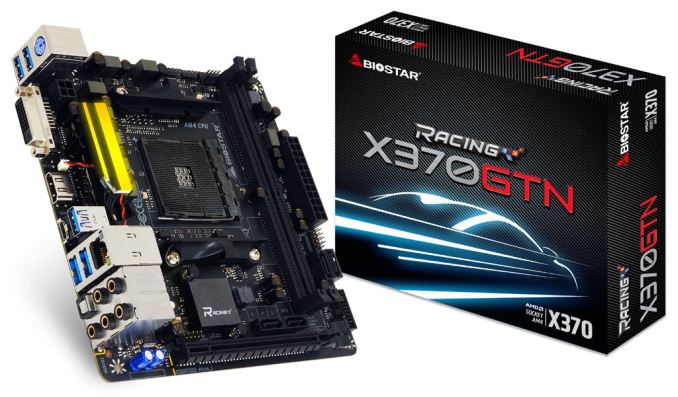The Biostar X370GTN Mini-ITX Motherboard Review: AM4 Goes Tiny
by Gavin Bonshor on October 23, 2017 9:00 AM ESTBiostar X370GTN Conclusion
The target market for the Biostar X370GTN is a relatively clear niche: AMD gamers on a budget that want small form factor systems. Due to there being only a few mini-ITX motherboards on the market, the 'budget' element is perhaps inconsequential - if you want a small form factor Ryzen motherboard, there are only a few options. Biostar can’t command the same premium as boards like ASUS would, but being the first to release such a board onto the X370 chipset has set a pricing precedent for other manufacturers to follow.
Limitations on mini-ITX motherboards are somewhat expected in relation to ports and expansion slots, but this offering from Biostar produces a reasonable showing. Aside from the X370 specific features such as USB 3.1 (10 Gbps), Biostar has opted to use the Realtek RTL8118AS Gigabit controller under the guise of 'gaming', due to the size and the FLY.NET bundled software that allows for networking prioritization. When the board was announced over six months ago now, I was expecting certain sacrifices to be made in the choice of core components, so the aforementioned Gigabit networking controller and the inclusion of the more basic Realtek ALC892 audio codec was to be expected. There are a few interesting design choices, such as 5k caps. The benchmark results do not look too out of the ordinary - except perhaps that power consumption at load which we are retesting.
With something this small, Biostar had to include support of current Bristol Ridge APUs, hence the HDMI 1.4 port and a DVI-D port. The Biostar X370GTN has the foundation for a small potent gaming system, although it perhaps lacks a little finesse we have become accustomed to with so many of the motherboards from the big four having a good baseline in BIOS support and software.
With a quick note to the overclocking capabilities, I was impressed with what such a small and compact board for under $110 could do; it certainly performed no worse than any of the other ATX form factor motherboards that we tested it against (and are writing up for review). The main caveat is voltage control within the BIOS and a distinct lack of being able to set specific voltages. Instead, users need to rely on adjusting the core voltage in incremental stages with the offset, or for this particular motherboard, we recommend using AMD's Ryzen Master software.
The Biostar X370GTN is an interesting option at $110. The choice of 5k capacitors isn’t up to my personal standards, but there is a bit of give and take with smaller boards that aren't from the big four motherboard manufacturers.
We have five other AM4 motherboards already tested that we're writing up for reviews, after which we will look at some of the others available. Requests in the comments.













31 Comments
View All Comments
h3ll0 - Monday, June 17, 2019 - link
I've had this board since late november 2017 and I've never encountered a single issue with it. Yes it's not made by the most well known brand, however biostar has been around just as long as Asus and other manufacturers so they must be doing something right. I have mine paired with a R5 1600 @ 3.8Ghz 1.35625V through ryzen master and 16GB 3200Mhz ram in a CoolerMaster Elite 130 with a . The one downside that is mentioned in the review is the lack of setting a fixed voltage value in the BIOS, however ryzen master works just fine. For all the people whinging about the small vrm heatsink, most VRMs don't even need a heatsink as they designed to run without one and can be rated from 85C-125C and still function just fine, the problem is when you push voltages high and have no airflow or a heatsink on them, so as long as there is either a heatsink or airflow, but ideally both, you'll be fine.